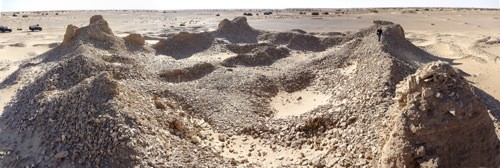University of Leicester archaeologists have made an astonishing find that could re-write history.
“It is like someone coming to England and suddenly discovering all the medieval castles,” according to Professor David Mattingly, from our School of Archaeology and Ancient History. He’s referring to the discovery of structures built by the Garamantes in what is now Libya’s south-western desert wastes – challenging prevailing views of this little-known ancient civilization.
The fall of the Gaddafi regime in Libya has provided archaeologists with the opportunity to explore the country’s pre-Islamic heritage fully for the first time.
Using satellites and air-photographs to identify the remains in one of the most inhospitable parts of the desert, a British team led by the University of Leicester has discovered more than 100 fortified farms and villages with castle-like structures and several towns, most dating between AD 1-500.
They have identified the mud brick remains of the castle-like complexes, with walls still standing up to four metres high, along with traces of dwellings, cairn cemeteries, associated field systems, wells and sophisticated irrigation systems.
The archaeologists will be returning to Libya as soon as security is fully restored to continue their work. They are working with the Libyan antiquities department and funded by the European Research Council, the Leverhulme Trust, the Society for Libyan Studies and the GeoEye Foundation.
The Garamantes?
Much of our knowledge of this lost civilization is from Roman accounts that describe them as barbaric nomads and troublemakers on the edge of the Roman Empire (and they weren’t the only ones).
Evidence suggests their presence in the Sahara desert as far back as 1000 BC, but the first written record of them is from 500 BC by the Greeks.
Contrary to contemporary accounts, recent research has revealed that the Garamantes were highly civilised, living in large-scale fortified settlements, predominantly as oasis farmers with innovative water extraction techniques. It was an organised state with towns and villages, a written language and state of the art technologies. The Garamantes were pioneers in establishing oases and opening up Trans-Saharan trade.
It is thought that the society declined and fragmented around 1,500 years ago due to change in climate conditions or overuse of the limited water resources.

